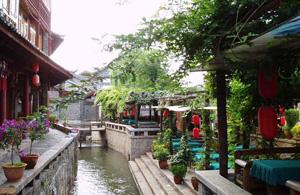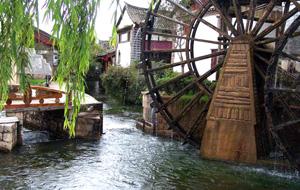
Lijiang old Town is officially called "Dayan Town", "Dayan" literally means a "great ink stab", a graphic description of the town's location on a piece of rich flatland fed by a river and surrounded by green mountains. Dayan Town is the large Naxi settlement first built during the Southern Song Dynasty some eight centuries ago.
Dayan Town is one of the few places in China with well-preserved old style folk buildings. In December 1986, the State Council designated the place as a famous ancient historical and cultural city of a national caliber. In 1997, the UNESCO put Lijiang on a list of the world's major cultural heritages.
There is no other town in China like Dayan which incorporates the folkways of so many people and the architectural styles of both north and south China. The town is on flatland about 2,400 meters above sea level. To its north are Mt. Xiangshan and Mt.Jinhong and to its west, Mt. Shizi, which effectively shield the town from winter winds.
Earthen and wooden housing structures are most popular in the old town. A typical courtyard here resembles what is found in Beijing-- walled and in neat squares, with the principle rooms facing south. Unlike the Beijing courtyard which has rooms facing east and west, spacious corridors line both sides of the Naxi courtyard which also has an imposing arch over the gateway.
Bridges are seen everywhere, linking streets and lanes. Many were built during the Ming and Qing period from the 14th to the early 20th centuries which have survived the wars and earthquakes. For all this, the town is known as the "Venice of China" or the "Suzhou on the plateau".
 The heart of the Dayan Town is called "Square Street"-business center which serves as a hub of communication to Sichuan Tibet and other parts of Yunnan. In addition, Sifang (square) Street is famous for being lined with little shops. Five major streets connect all the roads and lanes. Streets which run beside the streams are all paved with colorful cobbles. After rain, they look shining and neat. Naxi women, wearing their blue pleated skirts and sheepskin shawls decorated with seven stars and seven ribbons, add a lingering charm to the ancient town. Most of the residents of the Dayan Town are Naxi people. Their houses are traditional buildings with carved beams and painted rafters. The hereditary (master) of the Naxi minority all come from the Mu (wood) family.
The heart of the Dayan Town is called "Square Street"-business center which serves as a hub of communication to Sichuan Tibet and other parts of Yunnan. In addition, Sifang (square) Street is famous for being lined with little shops. Five major streets connect all the roads and lanes. Streets which run beside the streams are all paved with colorful cobbles. After rain, they look shining and neat. Naxi women, wearing their blue pleated skirts and sheepskin shawls decorated with seven stars and seven ribbons, add a lingering charm to the ancient town. Most of the residents of the Dayan Town are Naxi people. Their houses are traditional buildings with carved beams and painted rafters. The hereditary (master) of the Naxi minority all come from the Mu (wood) family.
Related News
Photos
More>>history
Traditions
arts
- SCUT holds opening ceremony for 2008 graduate students of professional degrees
- Architectural Design Institute receives important architectural awards
- HU Jintao receives HE Jingtang and other constructers of China pavilion of World
- President LI Yuanyuan and Academician HE Jingtang attend the Groundbreaking
- Press conference held for interpretation of SCUT's elements in 2010 Shanghai





